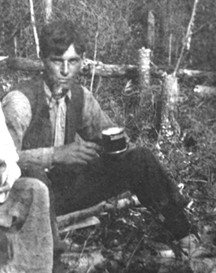
Mae
Guild Atwood, lifemask,
and clay tile she made as an art school
student in Boston, mid-1930s.
Guild Traces
notes on all that remains,
in my possession,
of this line
of my family
Guilds, as I know
them, are hands-on people -
builders, creators, and fixers. I have
some of my kin's tools and products, and a lot of their drive to keep busy
with the next and next practical, attractive (I hope)
project.
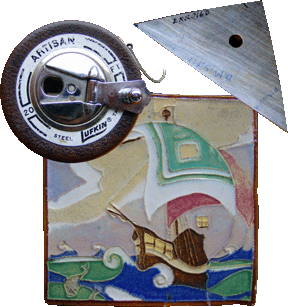
Ceramic
tile by James Wesley Guild, 1923;
Donald Maurice Guild's log-measuring tape, 1920s, and square, ca.
1918.
The name Guild, as my family says it, rhymes with 'child', 'mild,
'wild', 'riled'!
The 'i' is a long vowel, the way 'i' s were said in
the Middle Ages.
Since 2002, I've respelled it to "Guiled", to help
people pronounce it correctly. I'm batting about 500.
We continue to
say it this way because, as a linguist noted, we must have long
memories.
We must. It comes with being a Guild.
A good deal of what I know came from a times-removed cousin, Mae
Guild Atwood Barrett.
Her grandfather James Brisby Guild and my
great-great-grandfather Timothy Guild were brothers.
From her, I've
inherited the following book:
On December 26th, 1991, I, my husband, and two young children stopped quickly at Dedham, Massachesetts. We were beginning a cross-country drive to Vancouver, so I was in a rush. Luckily, the town's archivist was in that day, in the town's quaint brick museum. I said, "I'm Brenda Guild, I wonder what you might have on the Guilds, and I only have an hour."
He said, "Oh no, you're all the same. There are only 2,000 of you in North America, and you all, at some point, come tearing through here, wanting everything I've got in an hour."
Further, he said, since 1640, when the Guilds were first recorded in Massachusetts - forget other claims to have come in 1636, because he didn't have those records - they've married out until it's taken 20,000 people to make you. Why does that one old guy matter at all?
"Because he's my name," I said. "We say it 'guiled', as you obviously know, and I still believe we came in 1636, although I'd love to see your 1640 record of John Guild - that's my line."
I'd been told that we started the first weavers' guilds - said "guiled" then - in England, by way of Guernsey and Jersey. Old cousin Mae said that we came from Normandy before that, and from Norse lands earlier still.
A 'guild' was the payment made to belong to a work or trade group. The word has the same root as the Dutch coin, gilder. The person who payed a guild became a guild member. Some took the name Guild, although not many, and there still aren't many of us now.
title page of Guild book
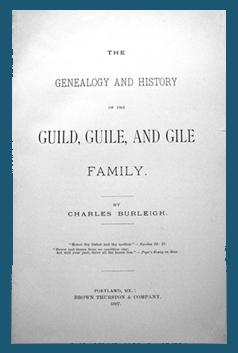
1.
John Guild
born in England, 16-teens;
died October 4, 1682;
married
June 24, 1645, Elizabeth Crooke of Roxbury, MA (born ?; died August 31,
1669)
![]()
John Guild's signature, from his Will
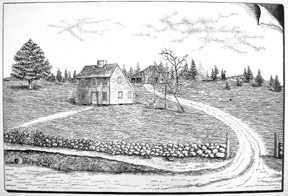
The house of John Guild, at Dedham,
built 1640.

The Guild house, now gone, was just south off old High Road. Guild Road remains a cul-de-sac midst centuries of infill.
Every man wishing to settle in Dedham before the early 1650s was required to sign the covenant below, a Utopian statement of community intent based on love, peace, fairness, justice, and mutual well-being. It was also a way of "keeping off from us all such as shall not be found fitting."
I really resonate
with this. Not the God-fearing parts, but the Utopian aspects.
My Guild kin have/had an idealistic streak that, for centuries, has kept them moving ever west and to less settled areas, where they could become groundlevel builders of new and better - they hope/d - communities.
The flip side is a tendency to high-horse judgments, impatience, and restlessness, which we need to recognize and temper. When things don't work out, we can be quick to sever ties and move on.
From the above book's introduction, page 17:
The brothers John and Samuel Guild, with their sister Ann, arrived about the year 1636, but the place from whence they embarked, the name of the ship in which they came, or the port of their arrival, are not positively known, neither is it ascertained beyond a doubt where they wre located previous to their going to Dedham, Mass.
They were probably quite young when they came, and judging from the dates of marriage of each, and of the qualifying of the brothers as freemen, it is conjectured that Ann was the oldest, being about twenty, John about eighteen, and Samuel about sixteen years of age.
It is probable that the two brothers John and Samuel, and their sister Ann, were in Dedham as early as 1637, as in this year, John subscribed to the town compact or covenant. In 1638 the marriage of Ann is recorded there. John is named among the original proprietors to whom land was granted on the first apportionment in severalty, in 1642; but as Samuel left in 1640 [for Newport, Connecticut], his name is not found as a landholder.
Ann Guild, John's and Samuel's sister, married James Allen in Dedham on March 16, 1638. Their four children were born in Dedham before they moved in 1649, to help found the settlement of Medfield.
Guild Road close-up, above, is from the Dedham Historical Society's "Notes on Historic Dedham" booklet.
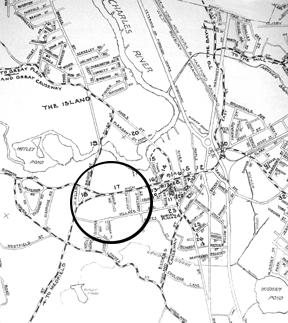
Map of
Dedham today,
a wealthy suburb of Boston
View Larger Map
My line traces through John Guild's son. I use 'survived' to mean
living to adulthood.
\/
2. Samuel Guild
firstborn of 7, 2 survived, both boys
born in Dedham, November
7, 1647; died in Dedham, January 1, 1730.
Married November 29, 1676,
Mary Woodcock of Dedham (born March 9, 1631-2, died
?)
\/
3.
Samuel Guild
firstborn of 10, 7 survived, 6 sons
born in Dedham,
October 12, 1677;
died in Lebanon, Conn, May 29, 1750;
married
January 8, 1700-01, Sarah Hartshorn (born in Reading, 1679, died
?)
\/
4.
Jeremiah Guild
fifth of 8 children, 7 survived, 2 sons
born in
Dedham, July 3, 1711;
Will signed at Middletown, Conn, 1748;
had
three children with second wife,
Elinor Evarts of East Guilford, Conn
(born 1748; died ?)
\/
5. Jeremiah
Guild
fourth of 4 children, 4 survived, 2 sons
born in
Middletown, Conn, Sept 4, 1746;
died at Warren, Conn, January 31,
1822
had 9 children with first wife, Hannah Hale of Middlefield, Conn
(born June 27, 1756; died in Warren, May 9, 1800)
\/
6. Timothy
Guild
second of 14 children, all survived, 7 sons
born at
Milton, Conn, October 21, 1779;
died Mallorytown, Ontario, Dec 25,
1838;
married Parna Plumb of Middletown, Conn (born ?; died
?)
The first Timothy Guild in my line moved to Ontario circa 1812, when son Julius was ~ six.
\/
7. Julius Guild
third of 7 children, all survived,
6 sons
born in Middletown, Conn, July 26, 1806;
died July 28,
1884;
married Margaret Mallory of Mallorytown, Ont, (born September
1801, died February 7, 1888); both buried at Blenheim,
Ontario.

Someone wrote on the back of this photo, "Uncle Timmy Guilds I think." Mae's firm hand then identifies this fellow as "Julius Guild" (quite different looking from another Julius Guild, son of the next Timothy). This photo appears to be mid-1800s vintage, so may be the first Canadian Guild in my line.
The second Timothy Guild in my line:
\/
8. Timothy Guild
third of 7 children, 5 survived, 6
boys
born in Mallorytown, Ont., February 6, 1824;
died in Oxford
Township, June 6, 1907;
married Mary Ann Gosnell of Oxford Township
(born November 28, 1837; died May 15, 1895, Guilds, Ontario).
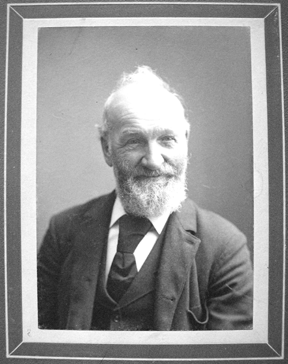
Timothy Guild - identified by Gladys Guild Hargreaves, my grandad's sister, as her grandfather.
A note by Mae's father calls him Uncle Timmy "Tickle Briches" [sic].
I saw gravestones for Guilds and Clevelands (my mother's maiden name) together in Dedham's old burying ground. In the Blenheim area of Ontario, these names again appear in proximity in graveyards. In the Jasper cemetery, in Alberta, Guild and Cleveland markers are also near each other.
While families move in similar patterns when pushed and pulled by larger forces, it's a bit uncanny to have paternal and maternal forebears showing up in exactly the same small, far-flung towns. I see an affinity at work here, perhaps even a fate (not of the planned variety, but, given the odds, a fitting inevitability.)
* * *
The second Timothy Guild had a younger brother, James Brisby Guild, grandfather of my old cousin Mae, who was an avid genealogist for her last 40 years. Her volumous work isn't, alas, consistently reliable, but it's a great work of heart and a heap of ore to be mined.
While I don't share her zeal for tracing long-lost cousins, I appreciate very much her work and lively character. To honour her, as a fine, bright woman on a great mission, I modelled a key character in my novel, Telling Maya (pages 11-18) after her.

The Guild homestead, Mallorytown, Ontario (northeast of
Kingston):
double-bricked, 14 rooms, with a furnace in the large basement.
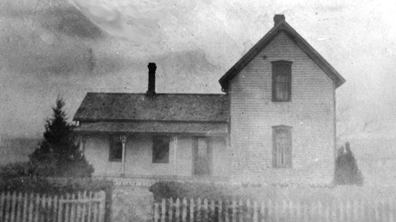
Timothy Guild's house, which he built in Guilds, Ontario (five miles from Blenheim)
George
Gosnell's daughter,
and Timothy's wife, Mary Ann Gosnell. He married
again after she died.

Blenheim, Ridgetown
area
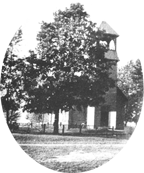
Guilds, Ontario, school
Finally, my great-grandfather:
9.
James Wesley Guild
sixth of 7 children, 5 survived, 4 boys
born
in Guilds, Ontario, December 21, 1868
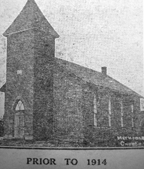
Guilds, Ontario, Methodist Church

James Wesley Guild,
1892,
purportedly his marriage photo from the
Senior Studio,
Blenheim, Ont.
In the
other certificate, he pledged to love, comfort, honour, and keep her in
sickness and in health ...
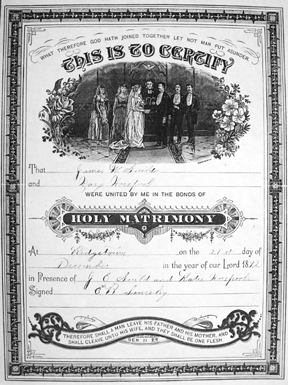
One of two marriage certificates; the other was witnessed by J.E.Guild (Julius Edwin, b. 1866 - not the older Julius above) and Katie Horspool.
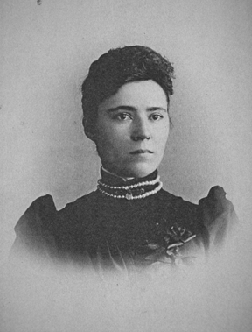
Mary Horspool,
1892,
also said to be her wedding picture, taken in Norton Studio,
Ridgetown, Ont. (Why different studios in different towns?)
... while she agreed to obey, serve, love, honour and keep him in sickness and in health.
Mary Horspool's mother and father, John and Harriet Horspool, were prominent farmers in the Ridgetown area. Mary was likely third of nine children, with two younger brothers, the rest sisters. The family maintained connections to Winnipeg - strongs ones, since Mary was buried there.
Soon after marrying, James and Mary took the train to Strathcona, now part of south Edmonton. They went with a group of people from Blenheim and Guilds, Ontario, to settle as a colony at Clearwater, NWT/Alberta, about 20 miles south of Edmonton. near Leduc (which was named by my grandmother's grandfather - LINK).
Gordon Grover Guild's was born at the home-stead. His birth certificate says he was born at Leduc, Alberta, on October 27, 1893 >
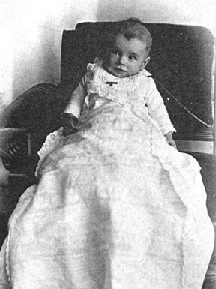
The birth of Gordon's s little sister, Gladys Gertrude, was also at the homestead, on June 1st, 1897, registered as Leduc.

1899: she's 2, he's 6.
James Brisby Guild moved to Clearwater to homestead in 1897. Mae, his granddaughter, wrote that he, his wife Mary, and baby Mae (born May 11, 1900) "tried hard to endure the cold and primitive hardships, but in March 1902, they left this farm and removed to Strathcona."
The James Wesley family moved to Edmonton after a few tough years, where he started the first Edmonton dairy, on Ross Flats by the river.

The handsome, thriving family, 1899.
My grandad, Donald Maurice Guild, was born at the Edmonton diary farm on August 28, 1905. He was two when first photographed.
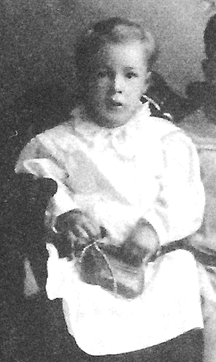
Toddler boys wore
dresses then, no problem.
The purse is a puzzle, but why wouldn't a
little guy like one?
Not long after Don was born, James Wesley sold the dairy, which became the Edmonton Dairy Company, a lucrative, long-running operation.
He took his family back to Guilds, Ontario, to be with Grandfather Timothy, who was ailing. He died in June of 1907.
They came west again, to Saskatchewan, where James started a dray (hauling) business. After less than a year, he moved his family back to Edmonton, where he continued his cartage company, which included moving pianos. Son Gordon helped him.
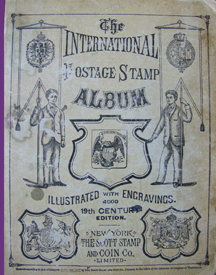
James
Wesley's 1908 edition of an album for 19th century stamps - nothing newer
than 1900.
It's a hodgepodge; it would take a great deal of work to
make something of it. It's a keepsake, one of the few things I own that
belonged to my great-grandfather Guild. I have nothing that belonged to
Mary.
He built a small house in the Norwood district of Edmonton - a place to live while he built a big house beside it.
This is how it looked a decade later. It was so large that, today, it's a condo with six suites.

From young Don's stamp album, with newer stamps. He wrote his address on it.
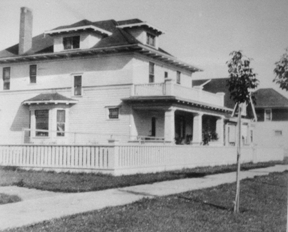
11516 - 95A
Street
Edmonton, Alberta
Gordon Grover worked at a bush camp by a lake near Prince George, in about 1913-14.
Link to Grandma & Grandad's webpage with photo of him leaving for war.
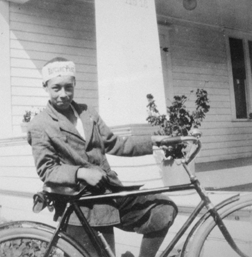
Grandad Don, wearing a paper Babco paint hat. He was a happy lad in Edmonton then.
His big brother had gone to war, but the odd letter came home reporting that he was alive and well enough. Gordon was "highly praised as a gallant soldier. He was tall and strong and a deadly bomb thrower."
Edmonton newspaper reports say that Gordon Grover was wounded on March 25th, 1916, hit by shrapnel in the back. He spent seven weeks in a British tent hospital, where he wrote home that they were treating him splendidly. "This is the first time that I have slept with my clothes off since I was on leave in London seven months ago."
After seven weeks, he was patched up well enough to return to the trenches of France.

A letter home to Mom, stamped Aug 15, 1916.
He was wounded, only slightly, soon after posting this letter. He mended sufficiently to keep fighting, hence be killed in action on September 10, 1916.
The Edmonton newspaper reported that Corporal Gordon Guild "was in the grenade platoon [in northeastern France] .... He was seen by a comrade just as the Canadians reached the wire in front of the German trenches, and, then, in the confusion, he was lost sight of and never seen afterwards. The attack took place at four o'clock in the morning, and the darkness, fog, and powder made it impossible for the troops to keep in touch."
No bodies were found, his or his whole section of 11 men, which led to speculation that they must have been captured and were in a German prison-of-war camp. This led, further, to great hope in his Edmonton home that he was alive. Several weeks passed before the awful truth was known.
My 11-year-old grandad's home started to unravel ....
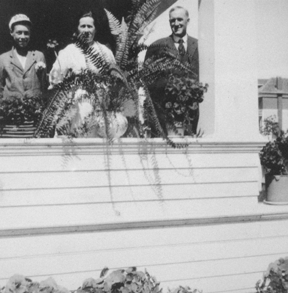
Mary, half-hidden. She still had some weight on her, which dropped through grim times.
Mary struggled to accept her son's brutal, senseless death. It tested her Methodist faith, and to assuage her doubts, she went to church ever more zealously to gain understanding, acceptance, and comfort. According to Grandad, these remained elusive.
Her health began to suffer. Four-and-a-half years after Gordon died, a letter came to Edmonton from Ottawa's "Militia and Defence":
|
March 15th 1920 433205 Cpl. Gordon Guild With further reference to the regretted death of the late solider marginally noted, I beg to inform you that it has been found necessary to exhume the bodies of soldiers buried in certain areas, and to re-bury them in recognised Cemeteries. The body of this soldier has accordingly been exhumed and re-buried. |
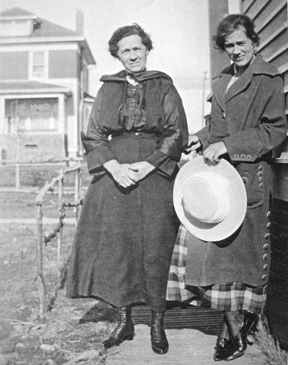
Mary and daughter Gladys, ~1919; last photo I have of Mary. Glad attended Camrose Normal School to become a school teacher.
His remains had been removed from the Courcelette Road Cemetery, Miramount, North Est of Albert and reinterred in the Regina French Cemetery, five-and-a-half miles N.W. of Albert, France.
According to the burial report, "Plot 1, Row A, Grave 17", was marked with a "Temporary Wooden Memorial erected with all particulars of the deceased inscribed thereon."
... "The late soldier marginally noted" with "all particulars of the deceased" on a little wooden cross. Belittling words that doubtless his hard.
Mary's health declined further, but I have no family records or hearsay about her condition. A doctor said she'd improve if she lived near sea-level.
In 1920, Mary, James, and 14-year-old Don moved to New Westminster. They kept the Edmonton house. Gladys went to teach Indian children at Lesser Slave Lake in her first one-room school.
James
sold his Edmonton cartage company to McCosham's - the second business he
started that the next owners turned into millions.
Grandad and his parents settled at 676 - 13th Avenue, New West - a house and house number that no longer exist. Mail came addressed to Burnaby, New Westminster.
Grandad said that his mom went up the hill to the Methodist Church several times a day. She often took him with her.
Grandma told me, in 1993 (I made notes), that "Don Guild shingled the church for free, while others went swimming." Grandma didn't know her future husband then, but her brief accounting of his family's history from the 1890s to the 1930s is more accurate than Grandad's own kin.
In
1922, the Ottawa Militia struck again.

I don't know what the valuable document said or held- perhaps Gordon Grover's dog tag? (which Gordon Hargreaves, Gladys's son, inherited. My thanks to him for this and other photocopied family materials and photos.)
The notice is
dated July 4th, so it arrived at their door shortly thereafter.
On August 17, 1921, Mary Horspool Guild gave up.
Her death notice in the Columbian newspaper:
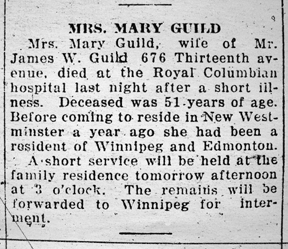
The
undertaker's spartan report is in James Wesley's hand.
It's at the New
Westminser Library; I couldn't make a copy at that time.
He
didn't supply her date of birth, but wrote that she was "51 years, 11
months, and 8 days old".
These are the words of a man, I believe, who
loved dearly and grieved deeply.
Grandad
turned 15 on August 28th. She left her second boy a week before his
special day
... truly a sick woman with no reserve or reason to stay
in this world.
Grandad and his dad moved back to Edmonton soon after.
They returned to the big house at 11516 - 95A Street in Edmonton.
Mary Horspool Guild's sister, Katie Horspool Scarlett, (who'd witnessed Mary's wedding; better known as Kit), lived in Edmonton. She had Don over for what she believed to be a health-giving soup - peas boiled to mush in milk, with no seasoning.
Grandma made very good vegetable soups, but never put peas in them. As a girl, I suggested once that she put peas in; that was when I heard this tale.
Gladys wrote to Mae, in 1959, "Dad then moved back to Ed again where I kept house for him and Don and taught school. I married about 1922 & Dad remarried, Ida M. Ellis, a widow we had known for years."
She was apparently a kind, calm woman, well-liked by all. She had a daughter Pearl and a son Elmer, both young adults at that time.
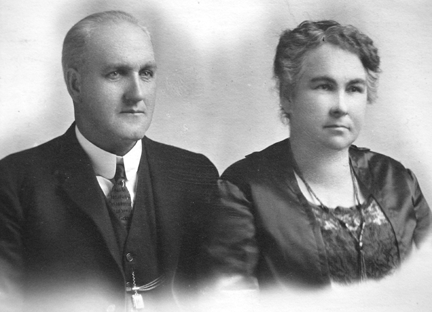
Grandma told me that
this was their wedding photograph, 1922.
I was about eight, which was
1959, the year she died. Must be why her photo came out.
He was 53
then; she was born May 15, 18about 50.
James
Wesley remarried in 1922. On June 12th, he, Ida, and Don left by train for
Vancouver, then on to Victoria for a couple days, where they caught a boat
to Los Angeles. Ida had a daughter in Anaheim.
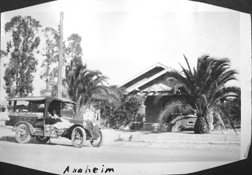
Mae
wrote, on Dec 12, 1923, that, "Uncle Jim expected to stay a year. They
didn't sell out [their house] in Edmonton. He bought a Dodge truck &
fixed it up for deliveries of vegetables. He started August 15th &
doing pretty well."

On
Jan. 23, 1924, Mae wrote that they were at 202 So. West [left] at Anaheim
Calif.
"Donald is here with them spending the winter and wants to work. ...
"Donald expects to go back to Edmonton in the spring and Uncle Jim and Aunt Ida want to go with him. Donald expects to work with Gladys' husband guiding tourists through the mountains."
< Xmas
1923
James on the left, Ida centre, with her kin
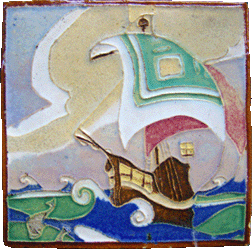
James made this tile at the L.A clay works.
On
March 2, 1924, Mae wrote, "Southgate P.O., Los Angeles, California. They
had moved her about a month ago. Had given up the fruit & vegetable
business at Anaheim because they could deliver only to certain parts of
the city, and that cut out 100 of their customers. ... They expect to move
again in a short time.
"Uncle Jim was working for a clay producing co. since they moved to Southgate. They may buy a small house."
Jim, Ida, and Don
returned to Edmonton in the spring of 1924. Don did go to work with
Gladys' husband, Jack Hargreaves, in the Jasper-Robson area.
Jim and Ida returned to the big Edmonton house, but sometime shortly thereafter, sold it and bought another house a few blocks to the west. I have no photos, that I know of, of 11841 - 95 Street.
He lived out his life there.
"James helped Don pick out land at Pedley in 1931," my grandma told me, according to my 1993 notes taken while she talked.
Gordon Hargreaves remembers, "a Turkey Farm (not chickens, or not just chickens, near Nisku, south of Edmonton - maybe 1928."
As a girl, I remember driving by the property and being told something about turkeys. Grandma just said that he started a "chicken farm, down 142nd, over the first bridge, had his property in there." She, Grandad, and my dad visited and stayed with them in the 1930s.
Ida kept a "little garden, with 1st-prize rhubarb" - at the farm, perhaps, or at their city house. I didn't ask which, and Grandma didn't say.
Mae wrote on Aug. 20, 1953, that "Jim was sick 9 years."
Gordon Hargreaves wrote on May 30, 1996, "I remember 'big' grampa ... when we visited him, as he lay sick (and trembling)."
James Wesley Guild died on January 16, 1939.
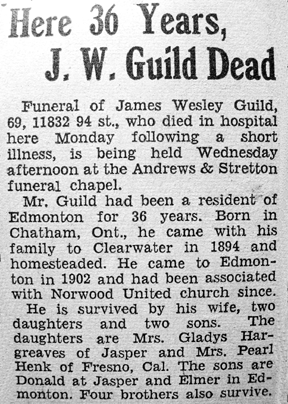
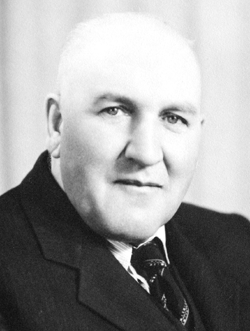

Ida Ellis Guild, same studio & date.
Ida wrote to
Mae's family (actual size card):

Dear Cousins
Just
a line to let you know poor Jim Passed away Jan 16th. Pneumonia set in at
last he put up a big fight to live no one knows all he suffered I never
once heard him say he wondered why he he had to be like that. So another
link is broken. No one knows how I miss him. we did mean so much to each
other. I
(continued on the
back side)
Wish I could go too. He had got quite thin but he looked so
nice in his caskett. Just looked as if he was going to speak. Gladys &
Don were both down everyone was very kind & thoughtfull to us which
helps a lot. He was in the Hosptiral 3 1/2 months I went every day and
about half of the time I went twice. Hope you will write sometime soon
This is rather short but I have so many to write and not feeling much like
it. Love Ida.
Mae wrote on Dec. 23, 1954: "Papa was right about Uncle Jim being so kind & doing for others. He was nothing but kind and nice to Aunt Ida."
Ida had anemia and diabetes. She lived to be 87 years old. She died Mar 10, 1959.

Bronze spelter
castings of Shakespeare and Milton, 1880s.
These were given to James
Wesley in Edmonton for his years of teaching Sunday school,
when, I don't know. He built houses and furniture, and he kept all his
possessions in good repair,
yet these foot-tall fellows, his stamp
album, and California tile are all I own that his industrious hands once
held.
